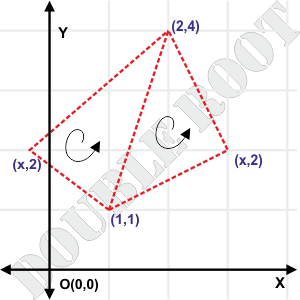Hi! This lesson is going to be pretty small. I’ll illustrate a few examples related to area, limiting myself to triangles as the methods for other polygons are pretty much the same.
Example 1 Find the area of the triangle whose vertices are (1, 2), (3, 0) and (4, 4).
Solution A simple problem. Just plug in the values and you’re done. Again, if we’re unsure about the order of the points, we can use the absolute value.
So, the required area is 1/2[1(0 – 4) + 3(4 – 2) + 4(2 – 0)] = 5
Note that this is not applicable for polygons with more than 3 sides. In that case, we must take the points in order.
Example 2 If the area of the triangle formed by the points (1, 1), (2, 4) and (x, 2) equals 4, then find the value of x.
Solution Here, we’ve been given the area, and have to find information about a vertex. Note that there will be two possible values of x. Look at the figure to get an idea.

By looking at the figure, we know why there are two possibilities. There are two positions of x for which we can place the three vertices in an anticlockwise order. We can take two cases and find the value in each case. Alternatively, we can use the modulus in the area, as follows 4=1/2|x(1-4)+1(4-2)+2(2-1)| or 8=|-3x+4|
This gives two values of x: 4 and -4/3
Example 3 Prove that the points (1, 2), (3, 4) and (0, 1) are collinear.
Solution Again? We already have two methods for doing this! But this one is interesting.
Three points are collinear if the area of the triangle formed by them is zero.
Well? Lets calculate the area then. 1/2[1(4 – 1) + 3(1 – 2) + 0(2 – 4)]=1/2[3 – 3 + 0] = 0 ! In a single line !
This becomes the quickest method to check collinearity of points. Always use this one instead of the other two. Well there’ll be one more method which will reign supreme. But we’ll come to that much later.
This brings us to the end of this lesson. See you in the next one! Goodbye!